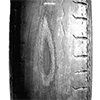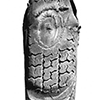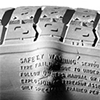
Common Tyre Problems
 Tyre Care, Tyre Checks, Tyre Maintenance, Tyre Problems
Tyre Care, Tyre Checks, Tyre Maintenance, Tyre ProblemsTyres are the cause of some of the most common problems that you will experience when owning a car. If you know what to look for in the day to day running of your car and how to prevent problems occurring in the future you will reduce the risk of having to deal with an expensive repair and painful inconvenience.
How Can I Look For Tyre Problems?
Is your car handling like it is driving on custard? Perhaps your fuel economy is dipping below the MPG that you would normally achieve? These are tell-tale signs that you may have a problem with your tyres.
The life of incorrectly inflated tyres can be up to 25% less than those that are correctly inflated. Checking your pressures are correct will reduce the running costs of your car and risk of permanent damage to your tyres. The correct tyre pressure range can be found in your vehicle handbook or by contacting your vehicle’s manufacturer.
Once you have ensured your tyre pressures are correct you will need to measure your tyre tread depth. The tread on each tyre must meet at least the legal EU minimum limit of 1.6mm. The 20p test is popular and industry recommended and requires you to insert a 20p coin into the lowest tread depth of your tyres. If the outer rim of the coin is visible it is below the legal limit and requires replacing. If the outer rim isn’t visible your tyre tread depth is safe.
Even if your tyre tread depths are safe and your tyres are correctly inflated a problem may still be present. Tyres wear abnormally as the result of excessive sharp braking or rapid acceleration. The guide below for what to look out for will help you when checking your tyres:
Illegal Wear
If you are undertaking a tyre check and your tyre resembles anything like the image above it needs replacing immediately. Any tyre in this condition has been used far beyond the legal tread depth limit.
Misalignment
You can spot a misaligned tyre as it will be worn noticeably more on one side than the other. For example, a tyre aligned inwards will wear more on the outside than the inside. If the tyre is aligned outwards the inner shoulders of the tyre wear more than the outer shoulders. You will be able to see this by eye or by running your hand across the tyre to feel for wear ridges.
Camber Wear
Cambered wheels result in increased wear on the outer edge of a tyre. Whether cambering has occurred due to poor fitting or has been deliberately achieved this significantly reduces the lifespan of a tyre.
Emergency Braking
If you perform an emergency stop the tyre wears enormously in an isolated area and can lead to deflation. If you have recently executed an emergency stop manoeuvre check your tyres for isolated damage.
Cuts And Tears
Observe the sidewalls of your tyres. Sharp objects such as nails, glass or metal can cause a cut or tear in the tyre. If a cut or tear is spotted it can render your tyre unserviceable.
Impact damage
If you hit an object at high speed such as a kerb a bulge may be visible in the side wall of your tyre. The area of the bulge or egg highlights the location of casing damage.
How Can I Prevent Problems Before They Happen?
If you are looking to maximise the life of your tyres and achieve optimal performance from your vehicle we suggest the following:
1. Ensure your tyres are correctly inflated
In most cases inflation issues occur because of under-inflation. This increases the daily wear on the shoulder of a tyre and means that it degrades prematurely. Moreover, vehicle handling becomes sluggish and unresponsive when under-inflation occurs. In some cases tyres are over-inflated which also inhibits vehicle handling and causes excessive wear on the centre strip of a tyre.
2. Don’t overload your vehicle
It is illegal to overload a vehicle and any trailers joined. You will need to be mindful of exactly how much your vehicle can load and avoid exceeding this. If you overload a vehicle increased strain is placed upon the tyres which raises temperatures, causes rapid wear and significantly heightens the risk of receiving impact damage that leads to premature failure. Consult your vehicle handbook to find pressures should you need to fully load your vehicle.
3. Manage your speed
Driving at speeds over long and short distances causes tyre temperatures to increase, which in some cases can lead to tyre damage. If you fail to have your tyres correctly inflated driving at high speeds also increases the likelihood of sudden tyre failure and rapid loss of air. If you want to maximise the life of your tyres observe speed limits and avoid aggressive acceleration/deceleration.
Unfortunately many tyre problems are unavoidable. You can check your tyres regularly but still fall foul of an errant nail, piece of metal or a pesky pothole. However, if you follow our guidelines and look out for tell-tale signs of potential problems you will already be going a long way to ensuring that you get the longest life possible out of your tyres. No matter how much TLC goes into your tyres the time will come when your tyres degrade and require replacing as tread depth drops below 1.6mm. When that time arises we can help!
We are experts in providing high-quality, low-cost tyres to suit any budget. Our friendly team will be happy to help with any tyre problems that you may have and can carry out a FREE tyre check on site. Click here to get in contact with our team now or pop in and visit our Poole tyre bay.
Nearside vs Offside – How to Tell the Difference
 Car Door Mirror, Car Parts, Car Parts Online, Nearside, OEM Parts, Offside, Spare Parts, Used Car Parts, Wing Mirror
Car Door Mirror, Car Parts, Car Parts Online, Nearside, OEM Parts, Offside, Spare Parts, Used Car Parts, Wing Mirror Common Ford 1.0L EcoBoost Engine Problems
 EcoBoost, Engine Problems, Engine Replacement, Ford, Used Car Engines
EcoBoost, Engine Problems, Engine Replacement, Ford, Used Car Engines 












